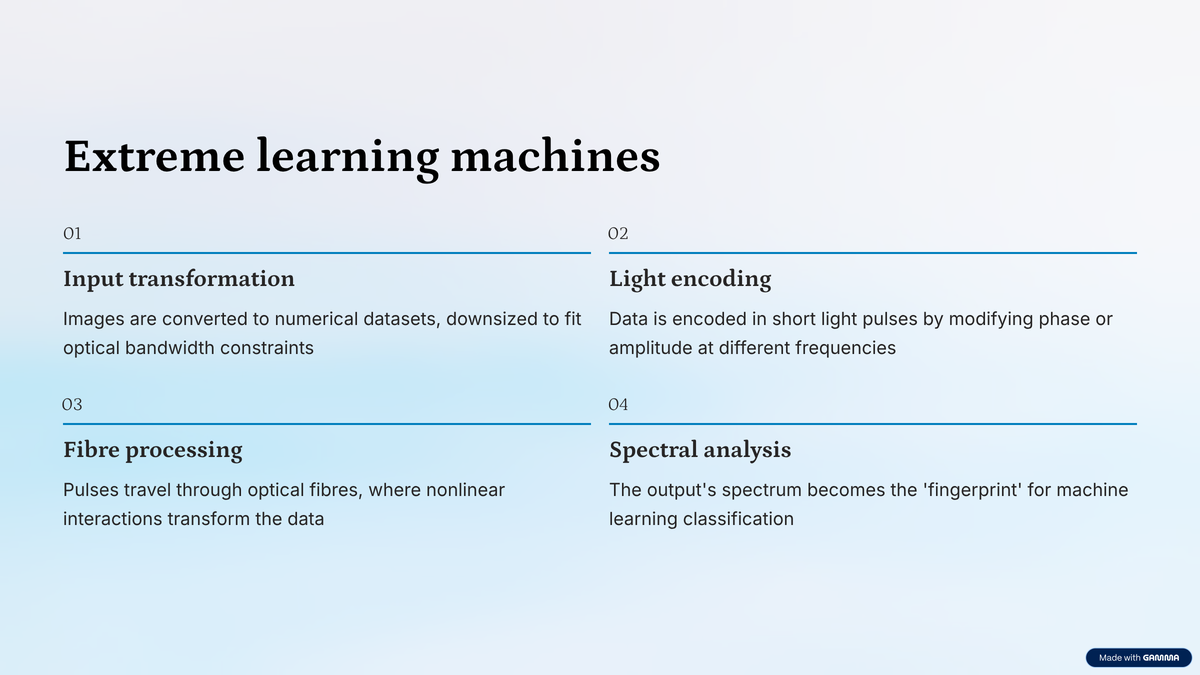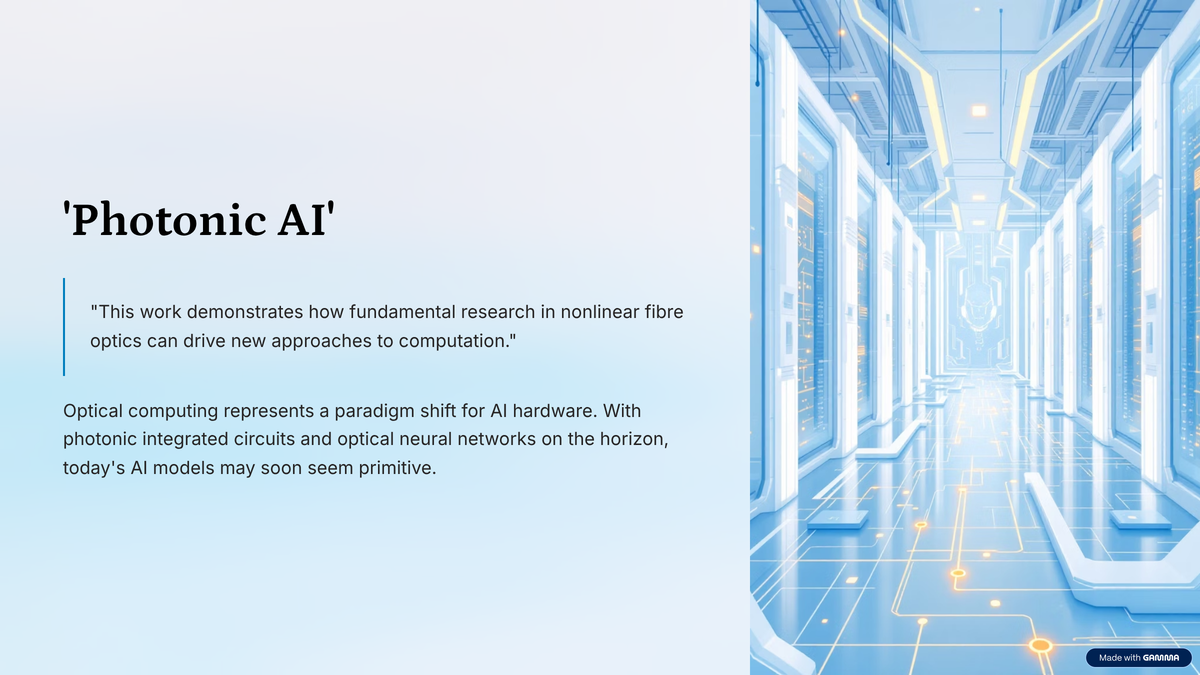Modern computing banks on conventional electronics and algorithms to process data. But because the hardware operates according to the laws of physics, there is a physical limit to the speed at which data can be processed. The availability of power further limits this speed, especially when the software running it is an artificial intelligence (AI) model. Thus, one of the main concerns of scientists around the world is coming up with new computers that push the speed limit by operating differently.
One promising approach is light-based, or optical, computing. These computers use photons, particles of light, rather than electrons. Because photons travel at the speed of light and photonic devices generate less heat than electronic devices, optical computing promises to be faster, have higher bandwidth, and be more energy efficient.
A key part of an optical computer will be the optical fibers that transmit data from one component to another in the machine. This particular technology is already in use around the world: it transmits billions of bytes of data between countries and continents and enables SuperFast internet services.
New door
But before scientists can use optical computing to supercharge AI models, they need some gripes to control certain physical properties of light. Light typically behaves in a regular, predictable way when it passes through a medium like glass or water. Scientists know this as the linear response of light.
However, when the light pulses are very intense, like those emitted by a powerful laser, they cause a different response from the material they pass through. This is the nonlinear regime. Among other things, light pulses in this regime can interfere with each other, disperse or merge, and create new frequencies (colors) of light.

Linear vs. Nonlinear Modes
Recently, two research groups—from the University of Tampere in Finland and the Université Marie et Louis Pasteur in France—studied the nonlinear interactions between intense pulses of light passing through thin glass fibers and discovered something unusual. The researchers reported that it is possible to harness the physics of light in optical fibers to perform complex AI tasks, potentially much faster and with less energy than traditional computers.
The work opens the door to new types of AI hardware that can be used in places where speed and efficiency are critical. The results were published in Optical Letters in June.
Image to numbers and back
In the study, the researchers focused on an AI model called an extreme learning machine (ELM). Instead of using traditional computer chips, they used the physical properties of light traveling through optical fibers to perform calculations. Their main goal was to understand how well this approach performed at image recognition and what factors affected its accuracy.
ELM is a fast and simple type of neural network. It has only one hidden layer (between the input and output layers) and only the output weights are trained. ELM finds these weights in a single step using a mathematical method, rather than learning through iterative corrections like in deep neural networks.
In this setup, the input data, like an image, was transformed into a set of numbers. This made it easier for the network to separate and classify different types of input. The ELM then used a simple linear calculation to match the transformed data with the correct label, such as what the number in the image represents.

Extreme learning machines
Pētnieki izmanto unikālās gaismas īpašības optiskajās šķiedrās, lai veiktu ELM nepieciešamo transformāciju.Katrs attēls vispirms tika samazināts – piemēram, no 28 × 28 pikseļiem līdz 10 × 10 -, lai ietilptu ierobežotajam gaismas pulsa joslas platumam. Pēc tam attēla dati tika kodēti uz ļoti īsa gaismas impulsa, mainot fāzi (kā gaismas viļņa svārstās) vai amplitūdu (cik spēcīga ir gaisma) dažādās frekvencēs.

Pirkstu nospiedums krāsās
Pēc tam kodētais gaismas impulss tika nosūtīts caur optiskās šķiedras garumu. Pulsa šķiedru mijiedarbība bija nelineārā režīmā. Pētnieki izsekoja, kā šķiedra reaģēja uz pākšaugiem un kā dažādas gaismas krāsas pārvietojas ar dažādu ātrumu – īpašumu, ko sauc par dispersiju. Šīs izmaiņas sajauc informāciju gaismas impulsos tādā veidā, ko bija grūti mainīt, bet noderīgi ELM pārveidošanas posmā.
Šķiedras beigās komanda izmērīja, cik daudz gaismas bija katra krāsa. Šajā spektrā bija sākotnējā attēla “pirkstu nospiedums”, ko pārveidoja šķiedras nelineārie efekti. Komanda to izmantoja kā slēptu slāni Elmā – skaitļošanas slānī starp ieeju un izvadi, kas radīja mašīnas “intelektu”.
Tādā veidā komanda apmācīja gobu tūkstošiem marķētu attēlu. Tad viņi pārbaudīja modeli uz jauniem attēliem, lai redzētu, cik precīzi tas tos varētu klasificēt.
Ar optimāliem iestatījumiem komanda atklāja, ka ELM ir vairāk nekā 91% precīza, lai atpazītu ar roku rakstītus ciparus, izmantojot optiskās šķiedras anomālās izkliedes režīmu un vairāk nekā 93% precizitāti normālā izkliedes režīmā. Šie rezultāti bija tuvu tiem, kurus sasniedza tradicionālās datorizētās ELM, bet tie tika sasniegti, izmantojot gaismas fiziku, nevis elektroniku.

Pārbaudiet ar attēliem
Lai ir gaisma
Saskaņā ar publicēto rakstu, palielinot nelineāro efektu stiprumu un šķiedru šķiedru garumu, uzlabojās precizitāte, bet tikai līdz punktam. Pārāk liels pieaugums izraisīja sistēmas nestabilu un mazāk precīzu. Tādējādi šiem parametriem ir optimāls diapazons.
Rezumējot, pētījums parādīja, ka optiskās šķiedras var izmantot kā jaudīgus rīkus mašīnu apguvei, īpaši tādiem uzdevumiem kā attēla atpazīšana. Rūpīgi noregulējot sistēmas parametrus un izprotot trokšņa un kodēšanas ietekmi, ir iespējams sasniegt augstu precizitāti, izmantojot gaismas dabiskās īpašības. Šī pieeja nākotnē varētu izraisīt jaunas, ātrākas un efektīvākas AI sistēmas.
Zinātnieki, kas vadīja komandas aiz pētījuma, paziņojumā sacīja: “Šis darbs parāda, kā nelineārā šķiedru optikas pamatpētījumi var virzīt jaunu pieeju aprēķināšanai.”
The research paper noted some limitations that she said could be overcome in future research. For example, the team’s model did not include all possible real-world effects, such as changes in the polarization of light (the direction in which its electric field oscillates). It said future work could also explore encoding information for different polarization states or using more complex optical fibers. It also identified potential for improving the system by measuring not only the intensity of the spectrum but also its phase.
That said, the study highlights the potential of light-based computing with optical fibers to meet the growing demand for faster, as well as smarter, AI. Using the speed and efficiency of light, future computers could think and learn in ways that could make AI models accessible to us today. But that will take many more years as experts and entrepreneurs develop and test new technologies, such as photonic integrated circuits and optical neural networks.

Paradigm shift
Qudsia Gani is an Assistant Professor in the Department of Physics, Government Degree College Patan, Baramulla.
Published – September 12, 2025 at 05:30












